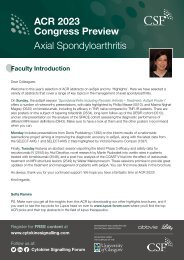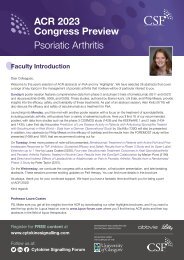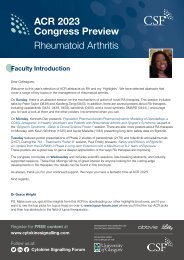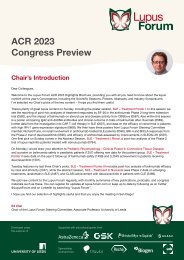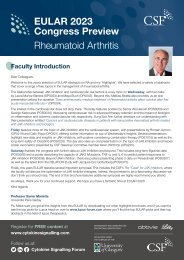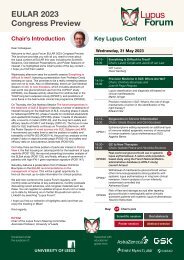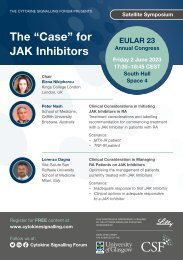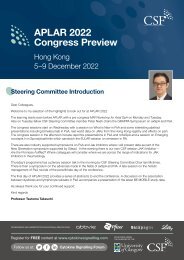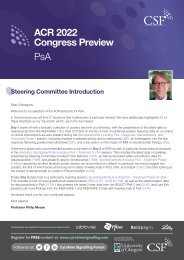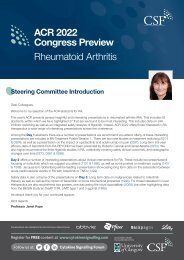EULAR 2018 Review
Create successful ePaper yourself
Turn your PDF publications into a flip-book with our unique Google optimized e-Paper software.
treatment with tofacitinib lead to significant reduction of 2 (VCAM and resisten) and<br />
borderline reduction in 2 (IL-6 and TNF-R1), and a significant increase in one (leptin).<br />
[#0089].<br />
Effect of tofacitinib on patient-reported outcomes in RA<br />
Patient-reported outcomes (PROs) in the ORAL Strategy study were reported by Strand<br />
and colleagues. Patients with RA and an inadequate response to MTX were randomised<br />
1:1:1 to receive tofacitinib 5 mg BID, tofacitinib 5 mg BID plus MTX, or adalimumab 40 mg<br />
(SC, Q2W) plus MTX; PROs were assessed at 6 and 12 months, and included HAQ-DI,<br />
patient global assessment (PtGA) visual analog scale) VAS, pain VAS, SF-36 Health<br />
Survey, EuroQol (EQ)-5D VAS, Work Productivity and Activity Impairment (WPAI) and<br />
Functional Assessment of Chronic Illness Therapy-Fatigue (FACIT-F). Baseline and<br />
disease characteristics were similar among the 1146 treated patients. At 6 and 12 months,<br />
improvements in PROs were similar with tofacitinib plus MTX and adalimumab plus MTX,<br />
and were numerically greater than with tofacitinib monotherapy [#0256].<br />
Tofacitinib efficacy and safety in PsA<br />
Helliwell, et al. showed that tofacitinib improved composite measures of disease in 2<br />
Phase 3 studies of patients with PsA. Patients with active PsA and either an inadequate<br />
response to ≥1 csDMARD and who were TNFi-naïve (OPAL Broaden; N=422) or with an<br />
inadequate response to ≥1 TNFi (OPAL Beyond; N=394) were assessed for Psoriatic<br />
Arthritis Disease Activity Score (PASDAS), DAS28-3(CRP), disease activity score for<br />
reactive arthritis (DAREA)/ Disease Activity index for Psoriatic Arthritis (DAPSA) and<br />
CPDAI. In each study, both 5 mg BID and 10 mg BID doses of tofacitinib showed<br />
improvements in composite endpoints versus placebo at 3 months; the largest effect size<br />
and standardised response means were observed for PASDAS [#0323].<br />
A post hoc analysis of the OPAL Broaden and OPAL Beyond studies was presented by<br />
Ritchlin and colleagues; this analysis examined tofacitinib efficacy and safety in patients<br />
with PsA and comorbid metabolic syndrome (MetS) and included 294 patients with active<br />
PsA plus MetS, and 416 patients with active PsA and without MetS. Tofacitinib efficacy<br />
was generally similar in patients with and without MetS, as determined by ACR20<br />
response rate, change in HAQ-DI, Psoriasis Area and Severity Index (PASI)75 response<br />
rate, change in and PtGA VAS. In patients with MetS, AEs and SAEs occurred in 55.6%<br />
and 2.0% (respectively) of patients receiving tofacitinib 5 mg, and in 42.6% and 2.0% of<br />
those receiving tofacitinib 10 mg; corresponding rates in patients without MetS were 42.4%<br />
and 1.4% (5 mg) and 54.8% and 1.5% (10 mg). The authors concluded that tofacitinib<br />
showed a generally similar efficacy and safety profile in patients with PsA with or without<br />
MetS [#0317].<br />
Burmester, et al. reported minimal changes in absolute lymphocyte counts and lymphocyte<br />
subset counts in tofacitinib-treated patients with PsA, up to 6 months. An analysis of<br />
pooled data the Phase 3 OPAL Broaden and OPAL Beyond studies of tofacitinib in 816<br />
patients with PsA who had an inadequate response to ≥1 csDMARD or ≥1 TNFi found<br />
minimal decreases in total T cells (CD3+), cytotoxic T cells (CD8+) NK cells (CD16+56+)<br />
and a numerical increase in B cells (CD19+). Up to Month 12, serious infections were<br />
reported in seven tofacitinib-treated patients and one adalimumab-treated patient. There



